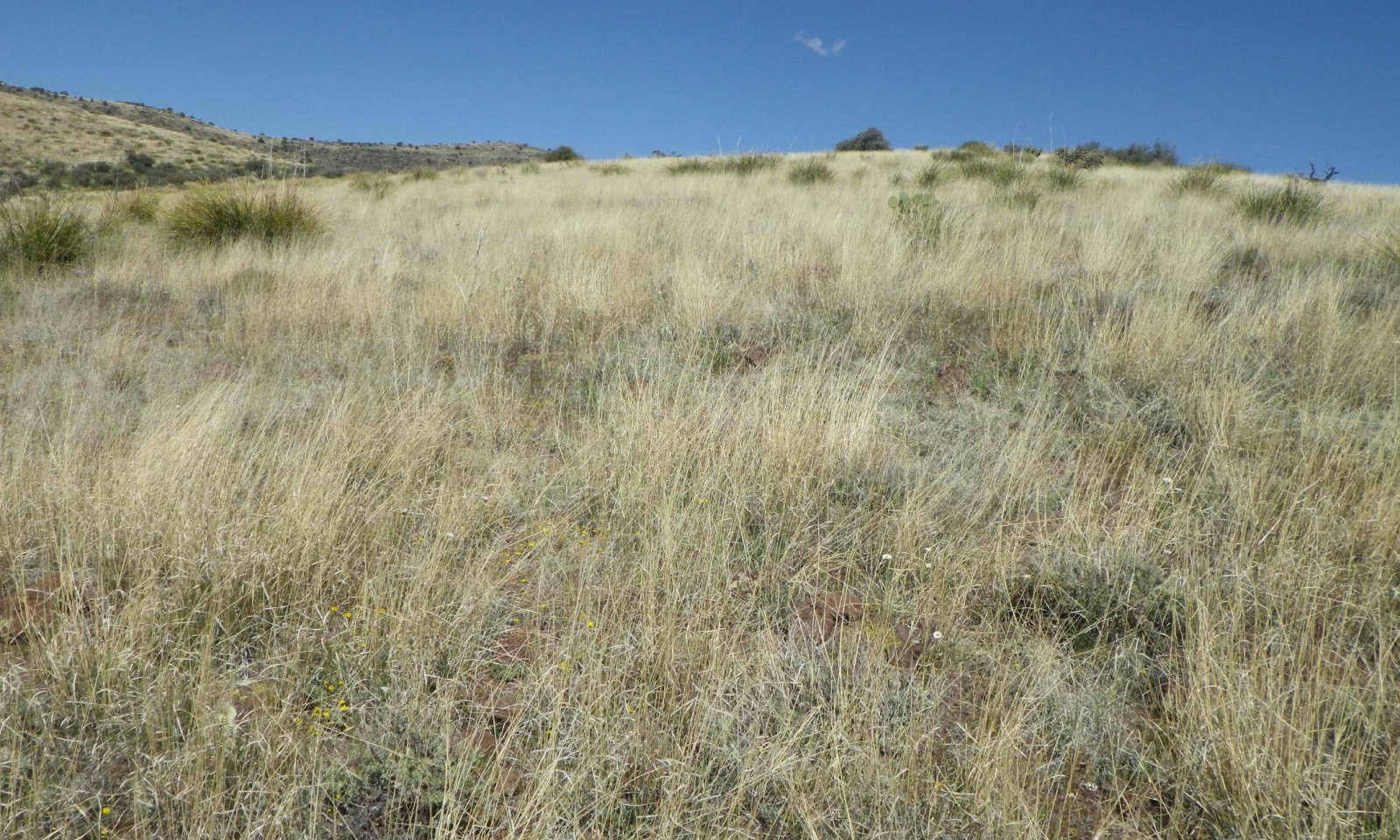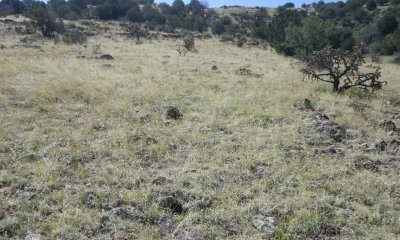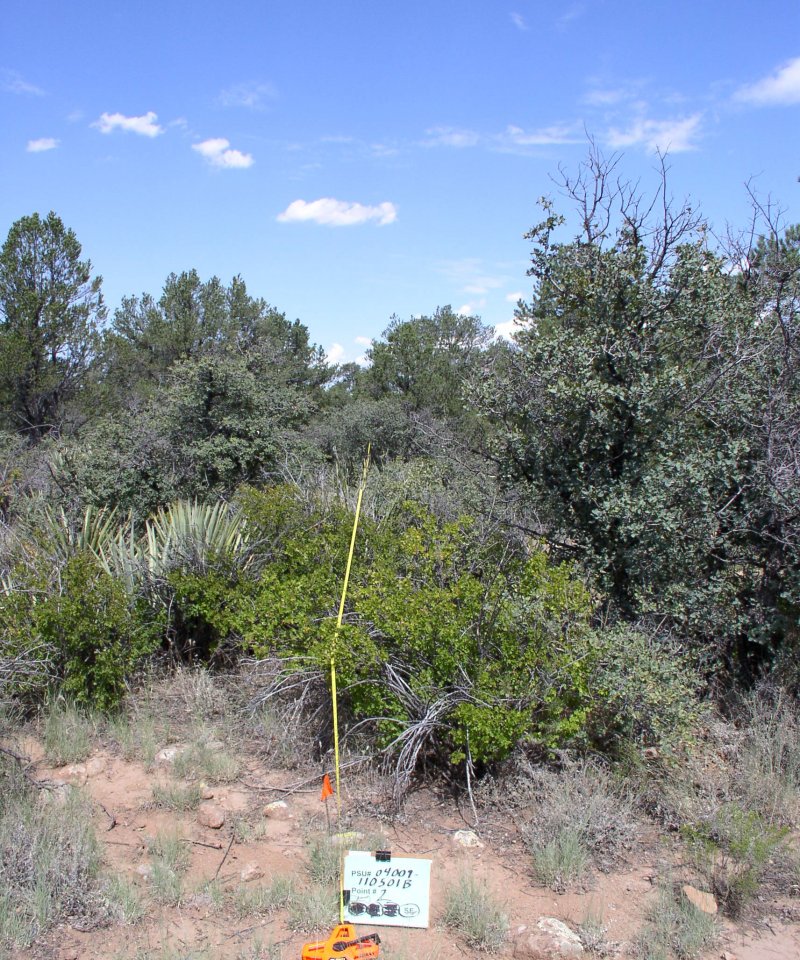
Volcanic Upland 16-20" p.z.
Scenario model
Current ecosystem state
Select a state
Management practices/drivers
Select a transition or restoration pathway
- Transition 1a More details
- Transition 1b More details
- Transition 1c More details
- Restoration pathway 2a More details
- Restoration pathway 3a More details
- Restoration pathway 4a More details
-
No transition or restoration pathway between the selected states has been described
Target ecosystem state
Select a state
Description
The historic climax plant community (HCPC) description was derived from a literature review and assessment of historic photos by The Nature Conservancy (Historical Range of Variation for Potential Natural Vegetation Types of the Southwest,June 2007,TNC). The best potential natural vegetation for this ecological site was sampled for point data to describe the reference community. This reference plant community can be described as belonging to the vegetation grouping by TNC as the mixed native grass type of the semi-desert grassland grouping. Within this type, the species composition varies greatly with soil type and topography. Historically, this vegetation type was found to be an open grassland with low shrub canopy cover (<10%) occurring in an upland position (Gori and Enquist 2003). According to the TNC, frequent fires maintained this grassland by killing young shrub and tree regeneration with fire return intervals of 2.5-10 years. Other studies have surmised that grasslands FRI corresponded to the surrounding woodland or forest. In the USFS-FEIS (Fire Effects Information System) the FRI for Pinyon-Juniper systems was less than 35 years and for interior ponderosa pine was 2-46 years. Dan Robinett suggested a FRI of 10-15 years in the Clay Loam Upland Ecological Site Description. Fire return intervals are difficult to determine in non-woody plant communities, due to lack of tree ring evidence, but likely occurred frequently and maintained a grassland versus a shrubland. The TNC used photo interpretation to show that historically the semi-desert grassland area was in an open grassland state, with very little in the shrub or tree state. TNC did a current regional assessment and found that only 17% of extant and former grasslands within the region can now be classified as open (<10% shrub cover) native grasslands. It is thought that missed fire cycles, drought and grazing have affected the rate of shrub increase, but the exact interactions are unclear (Brown and others 1997; Cable 1971; McPherson 1995; Robinett 1994).
Fires within the southwest are mainly lightning ignitions, covered large areas and occurred in June and July (Swetnam and Betancourt 1998). This timing occurred because of cool season moisture allowing some greenup and arid foresummer providing dry conditions followed by pre-monsoonal lightening storms providing ignitions. The dominant shrubs in the semi-desert grasslands are easily killed by fire as seedlings or young plants and don’t produce seeds until they are at least 10 years old. Therefore, frequent fires would avoid shrub invasion into grasslands. Many studies show large reductions in shrub cover, such as broom snakeweed and cacti after fires (Bock and Bock 1997; Humphrey 1949; Reynolds and Bohning 1956). Studies have also shown that most native perennial grasses show no negative effect after fire, recovering after 1-2 seasons or with drought 3-4 seasons (Bock and Bock 1992; Gosz and Gosz 1996; Cable 1972; Martin 1983; Wright 1980).
Normal drought coupled with other disturbance events such as unmanaged grazing can decrease perennial grass cover and increase sub-shrub cover. This is because perennial grasses are generally intensive water exploiters that have a dense network of shallow roots that can easily exploit water found in the shallow soil layers. Therefore, they are able to extract water from these shallow layers during light seasonal rains, where precipitation penetrates most frequently. The sub-shrub, snakeweed, is also an intensive exploiter, and occupies the same soil layers and therefore competes with perennial grasses (Weaver 1920; Campbell and Bomberger 1934; Jameson 1966). They differ in their shoot dieback during dormancy in that grasses usually dieback nearly to the surface whereas subshrubs only in part. This may allow subshrubs to dominate over perennial grass in areas with lower cover. The presence of broom snakeweed and shrubby buckwheat indicates a strong drought influence in the area. As well, Broom snakeweed increases due to lack of fire and has been shown to be an increaser species with grazing. Therefore, within the reference state there are two communities that can cycle naturally between each other.
The TNC did an intense literature review of native perennial grassland succession and developed the following model. It is thought that 2 years post-burn, grass would regenerate with 0-5% shrub canopy cover and this community would be maintained for a couple of years. In the absence of a stand replacing fire, shrub canopy cover would increase to 6-10% and this would be stable for 3-40 years. This is based on the average frequency of low, moderate and extreme wet winter precipitation events (every 20 years) and the time (about 20 years) it takes for shrubs to show large cover increases (3 fold) following these wet periods. Drought could also effectively maintain this community with low shrub covers, by killing young shrubs, for about 37 years. Prolonged drought has been shown to cause declines in shrub density and cover within these grasslands. They used moderate drought events (equal to 1950’s drought) in the model to transition vegetation back to its starting conditions within the state, using the average historic moderate drought frequency (from 1000 years of reconstructed winter precipitation data)(Ni and other 2001;Bock and Bock 1997; McClaren 2003; Turner and other 2003). Fire would return this community to one with 0-5% shrub cover. After forty more years, shrub cover could increase to 11-30% cover, again maintained for about 37 years with drought cycles. Stand replacing fire would return this community to one with 6-11% shrub cover. With increasing grazing management intensity, each community can transition to the next with higher shrub cover. When drought conditions are followed by wet winters, shrub cover can be exponentially increased leading to an altered shrub state.
Specifically, the reference community for this ecological site is a side oats grama dominated grassland with blue grama subdominant. The soils associated with this ecological site are shallow resulting in shallow rooted plants residing on this ecological site such as perennial bunch grasses in the reference state juniper species in the treed state and nolina and cane cholla in the shrub state.
Submodel
Description
The reference state transitions to the short grass state because blue grama can withstand heavy grazing pressure and drought (Sims, P. L.; Dahl, B. E.; Denham, A. H. 1976). Therefore, if these conditions occur, blue grama can outcompete, and dominant in the side oats grama reference grasslands. Blue grama can also grow in argillic horizons which would become evident if there is a loss of topsoil from erosion. The soil associated with this ecosite is clayey throughout (smectitic) and well drained. A study that looked at soil heterogeneity and distribution of plant species, showed through multivariate analysis, that Blue grama dominated in areas where Holocene surface deposits are deepest and the argillic (clay rich) B horizon is thickest (Buxbaum, Vanderbilt 2007). Therefore, if there are decreases in basal cover of side oats grama and decreases in top soil or A horizon, blue grama can outcompete side oats grama for dominance. It has fair tolerance to fire when dormant but experiences some damage if burned during active growth especially during drought (Owensby, Clenton E. 1970).
Submodel
Description
Drought, missed fire cycles and mismanaged grazing can increase shrubs and trees in areas leading to the altered states (shrub state, treed state)(Gori and Enquist 2003). Wet winters after periods of drought have also shown to convert grasslands to shrublands (Barton and other 2001; Grissino-Mayer and Swetnam 1997; Miller and Rose 1999; Swetnam and Betancourt 1998). The threshold that converts the reference state to the altered shrub or tree state is 35% shrub cover or 15% tree cover. The loss of perennial grass basal cover in converting to shrublands, generally increases bare ground cover thereby leading to higher exposure to wind and water erosion (Gori and Enquist 2003; Whitford 2002). This exposure to wind and water erosion can lead to losses in top soil and A horizons which would make re-colonization by grasses or at least the original species present, difficult even if shrub cover is decreased. The soil that is associated with this ecosite has a surface that is well covered by gravel, cobble and rock which protects from wind and water erosion. Therefore, many stressors have to occur synergistically to alter a community from the reference state to an altered state. In our model, we consider Nolina and Cholla species as acting as shrubs in succession. Nolina has been associated with disturbance, specifically as a “fire-caused subclimax” community ((Humphrey, R. R. 1958. 24: 193-253). Humphrey, Robert R. 1958. 61 p). It is also associated with heavy grazing and erosion, specifically in blue grama grasslands but presumably in side oats grama as well. Nolina reproduces sexually through seed production and asexually by sprouting (Curtin, Charles G. 2003). Nolina is typically only top-killed by fire, though burned plants are generally smaller and coverage and density are lower than unburned areas. It sprouts from the caudex following fire, whereas postfire seedling establishment was not reported. It has a root depth at a minimum of 50 cm, has a low salinity tolerance and a soil pH range from 6.5-9.5. Species of cholla can be heavy invaders of areas with exposed soil in which stem joints can take root in vegetative reproduction. It has been shown that “waves of invasion” typically occur four or five years after drought combined with grazing. Animals defecate seeds and carry stem joints stuck in their hide (Kunst, Carlos Roberto Guillermo 1990).
Submodel
Description
Studies have shown juniper species to invade neighboring grasslands (Ffolliott, Peter F.; Gottfried, Gerald J.;1992). Juniper species may invade this grassland and alter the community to one with 15-35% cover of trees and shrubs with only 10-20% cover of perennial grasses. Disruption in the natural fire cycle would allow Juniper species to invade grassland areas that have already been stressed by other disturbances such as drought or unmanaged grazing.
Submodel
Mechanism
Drought and continuous high intensity grazing with no summer deferment has decreased the cover of side-oats grama and transitioned the community to one dominated by blue grama.
Mechanism
The midgrass reference community can transition to a shrub dominated state with a decrease in the natural fire return interval, unmanaged grazing or drought.
Mechanism
Juniper species with an understory of shrubs has increased in the absence of fire to dominate the site.
Mechanism
Large scale restoration from this state is unknown. Contour ripping to break up the dominance of blue grama and allow other species to come in has been successful in blue grama dominated plant communities in central New Mexico (Pat Shaver, pers. comm.) and squirreltail is only observed in areas where pipelines have been ripped through blue grama communities north of Springerville, AZ. Contour ripping followed by range planting according to n NRCS Conservation Practice Specification developed by the local NRCS Field Office.
Mechanism
To achieve this restoration pathway, a remnant seed source or range planting, must occur. Cholla cover can be decreased by mechanical brush management. This form of management may be useful only in the short term though (Rocky Mtn. Forest and Range Exp. Stn. Annual Report 1968, pg. 37). Cholla can spread through vegetative reproduction and increased grazing pressure may add to active dispersal (Allen, L.J., Journal of ecology,1991,79(4), 1123-1135). natural or prescribed fire 3-5 years post treatment to facilitate killing of cholla regeneration followed by natural fire return internal of 10-15 years could also be applied.
Mechanism
Mechanical brush management can be applied followed by burning of skeletons if sufficient fine fuels are on site. Perennial grass canopy in the interspaces of trees can likely provide an adequate seed source for restoration following brush management or fires. Range planting should likely only be considered where perennial grass canopy in the interspaces of trees is less than 25%; however this threshold needs additional investigation.
Model keys
Briefcase
Add ecological sites and Major Land Resource Areas to your briefcase by clicking on the briefcase (![]() ) icon wherever it occurs. Drag and drop items to reorder. Cookies are used to store briefcase items between browsing sessions. Because of this, the number of items that can be added to your briefcase is limited, and briefcase items added on one device and browser cannot be accessed from another device or browser. Users who do not wish to place cookies on their devices should not use the briefcase tool. Briefcase cookies serve no other purpose than described here and are deleted whenever browsing history is cleared.
) icon wherever it occurs. Drag and drop items to reorder. Cookies are used to store briefcase items between browsing sessions. Because of this, the number of items that can be added to your briefcase is limited, and briefcase items added on one device and browser cannot be accessed from another device or browser. Users who do not wish to place cookies on their devices should not use the briefcase tool. Briefcase cookies serve no other purpose than described here and are deleted whenever browsing history is cleared.
Ecological sites
Major Land Resource Areas
The Ecosystem Dynamics Interpretive Tool is an information system framework developed by the USDA-ARS Jornada Experimental Range, USDA Natural Resources Conservation Service, and New Mexico State University.










